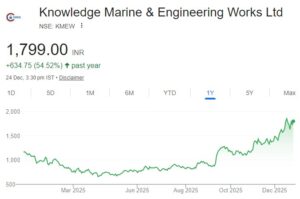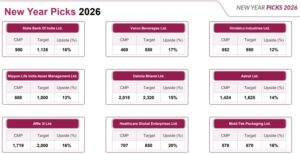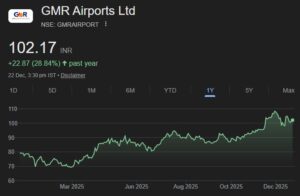(1) Understand the difference between Risk and Uncertainty:

Investors confuse between the two concepts. Ramesh Damani gives a practical example to explain the difference. In buying stocks like KFA, DCHL and Suzlon which are tottering on the brink of bankruptcy, there is a great “Risk” involved. However, in buying Blue Chip stocks which are growing at a steady pace year after year, there is no risk, though there is “Uncertainty” as to what the state of the stock market will be owing to short-term factors like Inflation, Budget, elections etc. If you are willing to look at your stocks over a period of time, 3, 5 or 10 years, even that uncertainty disappears.
In this, one is reminded of Warren Buffett’s timeless advice. When the interviewer asked him how he processes all the uncertainty and makes investment decisions, Warren Buffett answered:
“The world’s always uncertain. The world was uncertain on December 6th, 1941, we just didn’t know it. The world was uncertain on October 18th, 1987, you know, we just didn’t know it. The world was uncertain on September 10th, 2001, we just didn’t know it. The world – there’s always uncertainty. Now the question is, what do you do with your money? And if you – the one thing is if you leave it in your pocket, it’ll become worth less – not worthless – worth less over time. That’s certain – that’s almost certain. You can put it in bonds and then you can get a certain 2 percent for 10 years and that’s almost certain to be less than the decline and the purchasing power. You can put it in farms and the farms will probably keep growing corn and soybeans and they’ll grow it whether, you know, whether Italy has trouble tomorrow or not. It’s very interesting to me, if you own a farm and somebody said, you know, Italy’s got problems. Do you sell your farm tomorrow?”
The bottom-line of the advice is that what you think of as “uncertainty” is really not so and you are losing out on great buying opportunities.
(2) Train Your Mind To Mechanically Buy Stocks When There Is Uncertainty & Pessimism:
Ramesh Damani points out that investors act in an irrational manner when it comes to stocks. If a supermarket announces a sale or a discount, shoppers flock to the store and buy large quantities without any hesitation. However, the reverse is true for stocks. When markets are at a high, investors jostle each other to buy stocks and when markets are at a low, they shun stocks (see also Why The Average Raju Always Loses Money On Stocks)
One of the first visionaries to recognize this malaise was Benjamin Graham who, in his classic treatise “The Intelligent Investor“, advised investors to enter into an “agreement” with themselves that when the stock markets were down and out, they would rejoice and buy more stocks instead of wallowing in despair (see Chapter 8).
Ramesh Damani has a more simple and practical solution. He advises us to focus on all those days and events when the markets were seriously down, such as 9th March 2009, when the Nifty touched rock bottom, and it looked like there was no end to the “uncertainty“. If you look at the stock prices then and the stock prices now, you will kick yourself for having missed out on a great buying opportunity. If you focus on such events that have happened in the past, you will remove the fear from the mind and train it to react in a mechanical and emotionless manner and buy stocks at times of great pessimism.
Interestingly, Ramesh Damani candidly admitted that his biggest embarrassment was that during the entire crises of 2008-09, he never bought stocks the way he should have because he was a part of the collective frightened herd (see The stock picker who got it wrong).
(3) When You Are Supremely Confident Of A Stock, Buy Tons Of It:
Ramesh Damani explained how his failure to follow this seemingly simple piece of advice cost him a Forbes Billionaire position.
“The biggest failure of my life is in the inability to dream big” he said candidly.
In the late 1990s, Ramesh Damani was supremely confident about the prospects of two stocks: McDowell (now United Spirits) and Bharat Electronics. He knew that there was such a gigantic and profitable market for liquor in India that McDowell would do very well. Yet McDowell was quoting at such beggarly valuations that you could have bought the entire company at a market capitalisation of only Rs. 200 crores. The same was the story with Bharat Electronics, the blue chip PSU, which held the rights to all multi-billion dollar defence deals.
Ramesh Damani says he had the means to buy 10% of the equity capital of both companies. If he had done that, then, at today’s market capitalisation in excess of Rs. 50,000 crore for both companies, he would have been worth Rs. 5,000 crore. “I would have had to do nothing else. Just two stocks would have made me a Forbes billionaire” he exclaimed. “You will never get seriously rich by buying 2,000 or 10,000 shares. When you get a seriously attractive opportunity, back up the truck with the stock” he advises.
(4) There Are No Mistakes In Life; Only Learning Experiences:
Another priceless piece of advice from Ramesh Damani is that when you lose money on a stock, you must dispassionately and clinically analyze what went wrong with your calculation and assumptions, so that you can avoid making the same mistake again.
Another investing maestro who endorsed this technique is Mohnish Pabrai. Mohnish Pabrai cited the example of the Federal Aviation Authority (FAA) which, whenever there is a plane crash, goes to the site and makes a forensic evaluation of what went wrong and how it can be avoided in the future. Mohnish Pabrai said he had adopted the same technique and evaluated the mistakes that the great investment legends like Warren Buffett had made. He used this knowledge to make a check-list of the things to be careful about when making a stock investment.






Good post thanks.
I believe there are similarities between him and Mohnish Pabrai. Both had gone to US to do IT and became smart investors over time